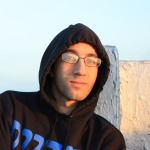Musings from Students of the Pardes Institute of Jewish Studies in Jerusalem
Posted on May 30, 2013 by Brian Blumenthal
For Zion’s sake will I not hold my peace, and for Jerusalem’s sake I will not rest, until her righteousness goes forth like radiance, and her salvation like a burning torch. (Isaiah 62:1)
 This semester in Yaffa Epstein’s Bekiut Talmud class we studied the 16th perek of Masechet Shabbat, titled “כל כתבי” (All of the writings). The perek focuses on what you can save from a fire on Shabbat—including holy writings (such as a Sefer Torah) and food for the Shabbat meals. The discourse in the chapter encompasses the meaning of holiness in relation to texts, Shabbat, and community.
This semester in Yaffa Epstein’s Bekiut Talmud class we studied the 16th perek of Masechet Shabbat, titled “כל כתבי” (All of the writings). The perek focuses on what you can save from a fire on Shabbat—including holy writings (such as a Sefer Torah) and food for the Shabbat meals. The discourse in the chapter encompasses the meaning of holiness in relation to texts, Shabbat, and community.
Following a lengthy discussion of Oneg Shabbat (the joyful essence of Shabbat) and all of the actions associated with the special day—including preparation (Hachana), welcoming (Kabbalat Shabbat), eating (Seuda), and even escorting (Melava Malka)—the Gemara brings up the topic of what you are NOT supposed to do: desecration (Chillul Shabbat). This then launches into a sugiya (section) talking about the destruction (Hurban) of Jerusalem:
Abbaye said: Jerusalem was destroyed on account of desecration of Shabbat. (Shabbat 119b)
Although it is not discussed explicitly in the Gemara, it seems like the Rabbis here are trying to present a connection between Jerusalem and Shabbat. As I prepare for my final Shabbat in Jerusalem, this connection is definitely on my mind. There is nothing quite like Shabbat in Jerusalem. It is something one has to experience in person, and I am extremely fortunate to have had this experience for the past 12 months. Shabbat, the holy day, and Jerusalem, the holy city, clearly have an eternal bond. Yes, Shabbat exists and will exist (for me) in other places. But it will never be like it is in Jerusalem.
The sugiya is bookended by short sections that talk about words from the root .א.מ.נ (including אמן and נאמן). The first section comes at the end of the long Oneg Shabbat discussion, and I see this as the Gemara’s “Amen” to Shabbat: “Yes, It is true”. This can also be thought of as the “Amen” that comes at the end of the last blessing of Havdalah, HaMavdil. It reminds me of doing Havdalah in a large group of friends, at the conclusion of spending a beautiful Shabbat together. That final Amen, which often launches the group into song and dance, puts the seal on Shabbat for that week, allowing you to approach the coming week anew. One of the Gemara’s approaches to the word is as an an acronym for אל מלך נאמן (God is a truthful king). This formation of .א.מ.נ returns at the end of the sugiya, in a discussion about אנשי אמנה or truthful people:
Rava said: Jerusalem was destroyed because truthful people ceased from it. (Shabbat 119b)
Bookending this section with ‘truth’ seems to stress the importance of this idea. However, ‘truth’ is a difficult word—especially in the Gemara. In fact, the next statement offers a refutation of what was previously said. While this complicates the whole notion of ‘truth’, it possibly perpetuates the idea of multiple truths. The reconciliation of these truths is at the heart of the Gemara and Talmud Torah.
The Rabbis further complicate the situation by discrediting their own words.
Reish Lakish said in the name of Rabbi Yehuda Nesi’a: The world endures only on account of the breath [words] of school children. (Shabbat 119b)
When Rav Pappa asked Abbaye about the importance of the words of the Rabbis, Abbaye answered that they simply cannot compare. These statements really stood out to me, and I think they ultimately provide the message of the sugiya. The most important thing about Jerusalem—and the World—is that children are learning. In this sugiya, this seems to be getting at the ‘truth’. Learning Torah—in order to keep the tradition alive—is truth.
In the middle of Shabbat, a time of joy for the Jewish people, we are reminded of the importance of young people learning. Although we are not children, many of us at Pardes are still in the early stages of our Torah learning journeys. We have taken a year (or two) to fully devote ourselves to studying Tanach, Gemara, Halacha, Jewish Thought, and more. I have been blessed to have had this experience, which has stressed the importance of learning Torah for Jewish communal leadership, education, and life. As long as Pardes continues to share its open Beit Midrash experience with the world, the future of the Jewish people remains bright.